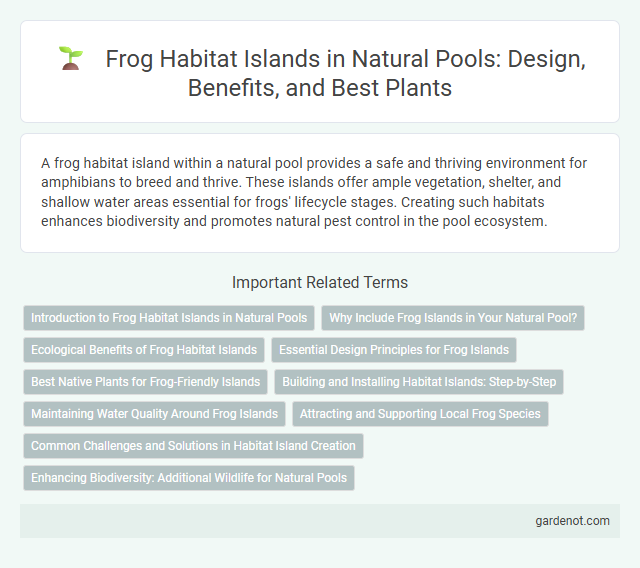A frog habitat island within a natural pool provides a safe and thriving environment for amphibians to breed and thrive. These islands offer ample vegetation, shelter, and shallow water areas essential for frogs' lifecycle stages. Creating such habitats enhances biodiversity and promotes natural pest control in the pool ecosystem.
Introduction to Frog Habitat Islands in Natural Pools
Frog Habitat Islands in natural pools serve as crucial microhabitats designed to support amphibian life by providing shelter, breeding grounds, and protection from predators. These islands often feature native vegetation and shallow water zones that mimic natural wetlands, promoting frog population sustainability and biodiversity. Integrating frog habitat islands into natural pool design enhances ecological balance and fosters a thriving environment for local amphibian species.
Why Include Frog Islands in Your Natural Pool?
Frog habitat islands in natural pools provide essential breeding grounds and safe refuge for amphibians, promoting biodiversity and enhancing ecological balance. These islands support natural pest control by attracting frogs that consume insects, reducing the need for chemical interventions. Incorporating frog islands improves water quality through natural filtration and fosters a healthy, sustainable aquatic environment.
Ecological Benefits of Frog Habitat Islands
Frog habitat islands within natural pools enhance biodiversity by providing safe breeding grounds and shelter for amphibians, which are vital indicators of environmental health. These islands support the control of insect populations, contributing to natural pest management and reducing the need for chemical interventions. Moreover, the presence of frogs promotes nutrient cycling through their role in aquatic and terrestrial ecosystems, fostering a balanced and thriving habitat.
Essential Design Principles for Frog Islands
Frog habitat islands in natural pools must incorporate shallow slopes, dense native vegetation, and varied microhabitats to support breeding, shelter, and foraging needs. Essential design principles include maintaining water quality without chemicals, ensuring gradual water depths for safe frog access, and providing shelter through natural materials like logs and stones. Integrating these elements promotes biodiversity, aids amphibian conservation, and enhances the ecological balance of the aquatic environment.
Best Native Plants for Frog-Friendly Islands
Selecting the best native plants for a frog-friendly island in a natural pool involves species like pickerelweed (Pontederia cordata), watermint (Mentha aquatica), and soft rush (Juncus effusus), which provide essential shelter and breeding grounds. These plants contribute to water quality by filtering pollutants and offering insects and algae as food sources, enhancing the ecosystem's biodiversity. Incorporating a variety of native aquatic and marginal plants supports amphibian life cycles, creating a balanced, sustainable habitat for frogs.
Building and Installing Habitat Islands: Step-by-Step
Building and installing frog habitat islands in a natural pool involves creating floating or anchored platforms using materials such as untreated wood, natural fiber mats, and aquatic plants to mimic the frogs' natural environment. The installation process includes securing the island in shallow water areas, ensuring stability and accessibility for frogs while promoting vegetation growth for shelter and breeding. Proper positioning and maintenance enhance biodiversity, support amphibian reproduction, and contribute to the ecological balance of the natural pool ecosystem.
Maintaining Water Quality Around Frog Islands
Maintaining water quality around frog habitat islands in natural pools involves careful management of pH levels, nutrient balance, and pollutant filtration to support amphibian health. Implementing biofiltration systems with aquatic plants and beneficial bacteria helps reduce harmful nitrates and organic waste, ensuring a stable environment for frog populations. Regular monitoring of temperature, dissolved oxygen, and contaminant levels is essential to preserve the delicate ecosystem unique to frog habitat islands.
Attracting and Supporting Local Frog Species
Frog habitat islands in natural pools provide essential shelter, breeding grounds, and abundant food sources that attract local frog species. These islands support amphibian populations by offering diverse vegetation and shallow water areas that mimic natural wetlands. Creating such habitats enhances biodiversity and promotes a balanced ecosystem within the natural pool environment.
Common Challenges and Solutions in Habitat Island Creation
Creating a frog habitat island within a natural pool involves challenges such as maintaining appropriate water quality, providing sufficient shelter, and ensuring a stable ecosystem to support amphibian life cycles. Solutions include incorporating native aquatic plants for oxygenation and cover, designing varied terrain with shallow edges and submerged logs for breeding and protection, and regularly monitoring water parameters to prevent pollution and predation. Controlled introduction of frogs and natural predators helps establish a balanced environment that promotes sustainable frog populations.
Enhancing Biodiversity: Additional Wildlife for Natural Pools
Frog habitat islands in natural pools create essential breeding and shelter areas that significantly boost local biodiversity by supporting amphibian populations and other wildlife. These islands provide varied microhabitats, encouraging a balanced ecosystem with natural pest control and improved water quality through the presence of diverse organisms. Integrating frog habitat islands enhances the ecological function of natural pools, promoting a thriving environment for both aquatic and terrestrial species.
Frog habitat island Infographic

 gardenot.com
gardenot.com